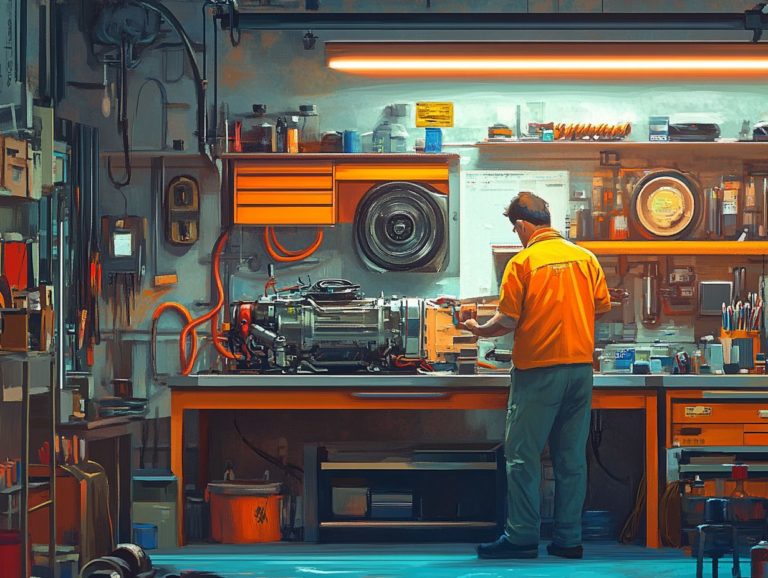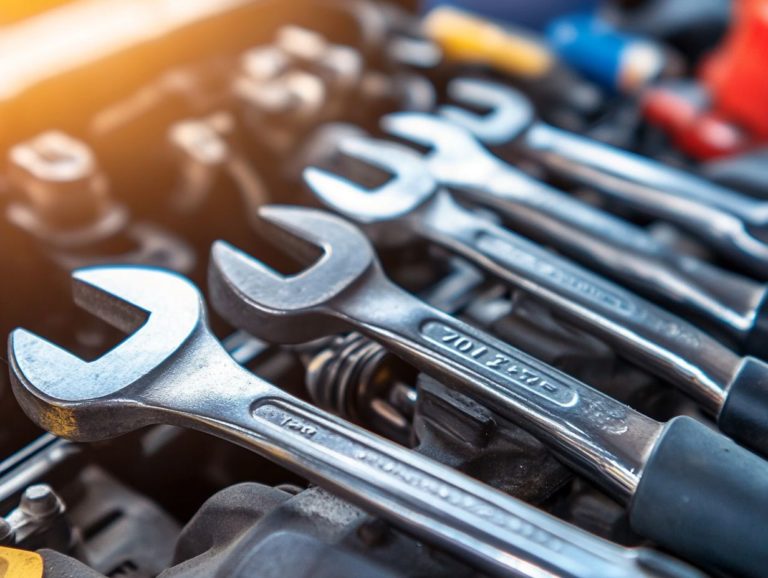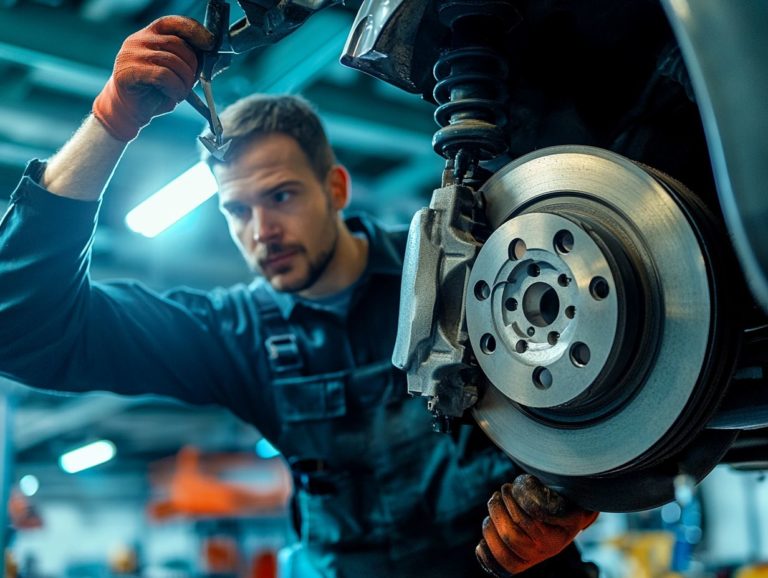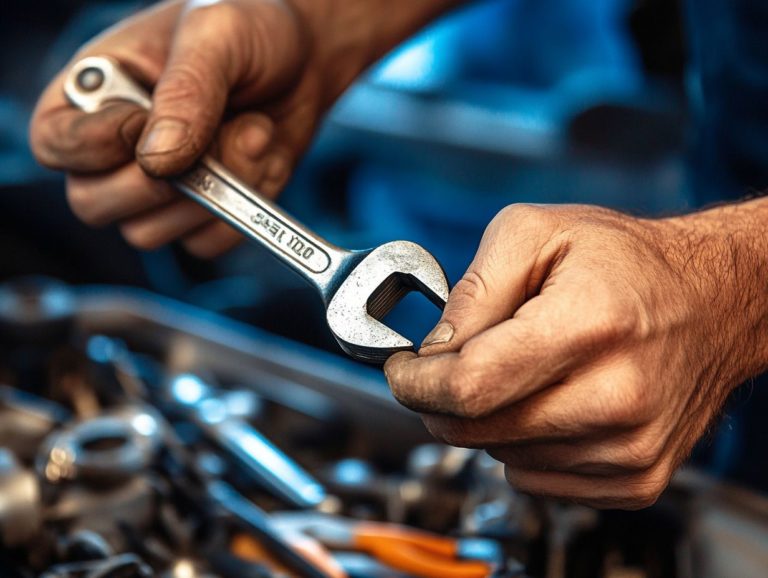5 Tips for Quick Common Car Repairs
Keeping your car in peak condition doesn t always necessitate a visit to the mechanic. With a handful of straightforward tips and tricks, you can tackle many common repairs quickly and effectively right at home!
This article highlights five essential tasks such as checking fluid levels and maintaining tire pressure that can help you avoid larger issues down the line. Discover how to keep your ride running smoothly!
Contents
Key Takeaways:
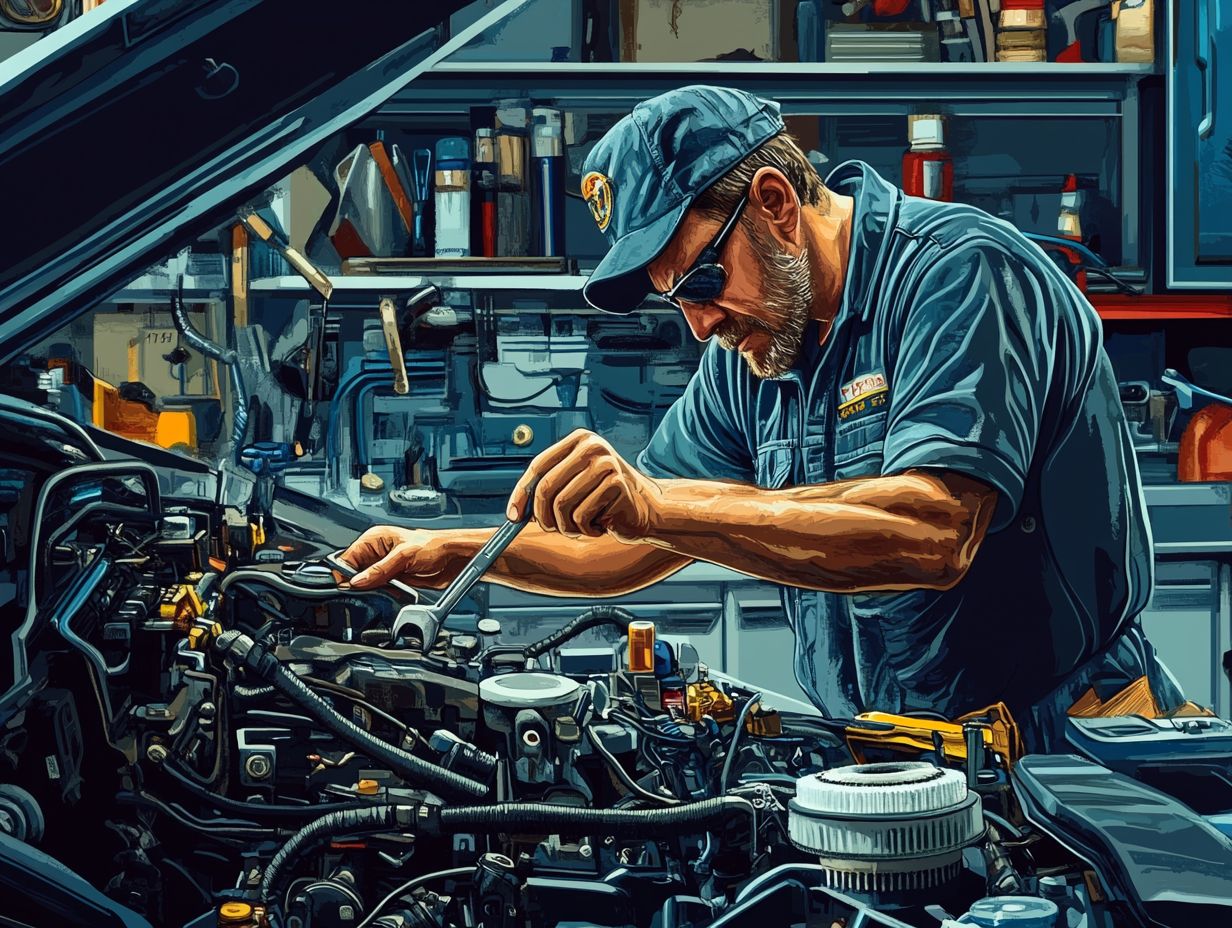
- Regularly checking fluid levels can prevent major car repairs and save you money in the long run.
- Properly inflated tires can improve gas mileage, handling, and prevent common car issues like blowouts and uneven wear.
- Replacing worn-out windshield wipers can improve visibility and safety, especially during inclement weather.
1. Check Your Fluid Levels Regularly
Regularly checking your fluid levels is crucial for maintaining your car s peak performance. By doing so, you ensure that essential components like the engine, brakes, and cooling system operate efficiently. This helps you avoid major repairs and extends your vehicle s lifespan.
When you take a moment to inspect and top off vital fluids such as engine oil, coolant, and brake fluid, you help prevent potential breakdowns. For instance, if your oil levels dip too low, you risk inadequate lubrication, which can lead to serious damage both of which will hit your wallet hard with costly repairs that could have easily been sidestepped.
Neglecting coolant checks can result in overheating, which may warp engine parts and lead to expensive fixes. Skipping brake fluid checks can compromise your braking system, making it less responsive and increasing the risk of accidents.
By allocating a reasonable maintenance budget, you empower yourself to tackle these issues before they escalate. This proactive approach ensures your vehicle runs smoothly while ultimately saving you money in the long run!
2. Keep Your Tires Properly Inflated
Keeping your tires properly inflated is essential for effective car maintenance. When you maintain the correct tire pressure, you enhance fuel efficiency, improve handling, and significantly reduce the risk of blowouts all of which can save you on repair costs.
Regularly checking your tire pressure is vital for ensuring a smooth driving experience. Worn or improperly inflated tires can lead to uneven wear on crucial components like brakes and suspension systems. This not only drives up your maintenance costs but can also jeopardize your safety. Timely tire replacements help you avoid these pitfalls and promote better traction on the road, ensuring your vehicle performs at its best.
By prioritizing tire care, you can enjoy a more efficient ride, extend the lifespan of your tires, and maintain a safer driving environment.
3. Replace Worn Out Windshield Wipers
Replacing worn-out windscreen wipers is a straightforward yet essential aspect of car maintenance that dramatically improves your visibility during poor weather, ultimately safeguarding your driving experience.
You ll notice it s time for a replacement when you see streaks across your windshield, experience skipping during their operation, or detect a decline in their flexibility. Ignoring these signs can lead to serious consequences; diminished visibility can create perilous driving conditions, especially in rain or snow.
By investing in new wipers, you not only enhance clarity and comfort while driving but also elevate your overall safety. Upgraded wipers provide a smooth, unobstructed view, allowing you to respond quickly to hazards and changing road conditions, fostering a more confident and secure journey!
Don’t wait until it’s too late! Share your own car maintenance tips and check out this guide on how to budget for common car repairs to help others keep their vehicles in top shape!
4. Change Your Air Filter
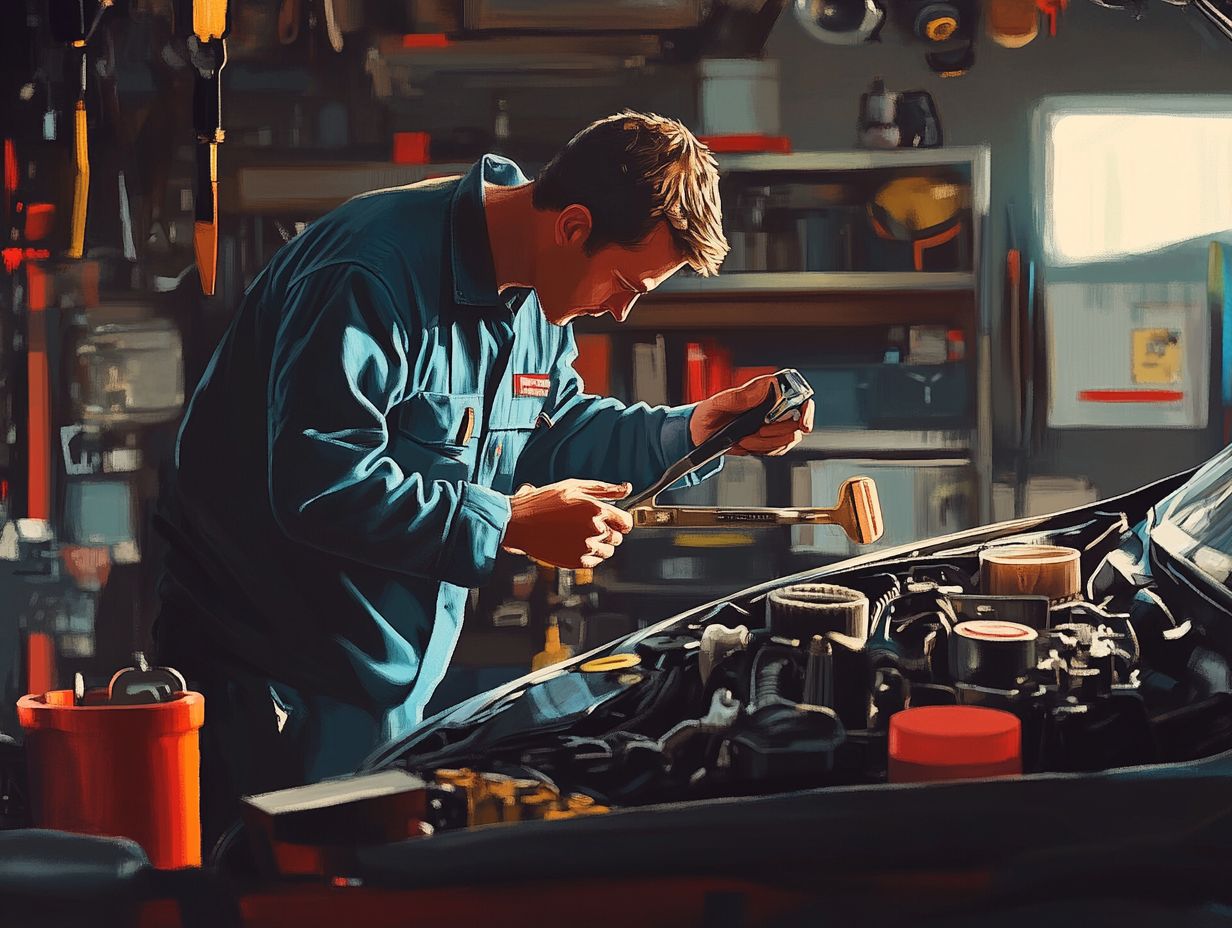
Regularly changing your air and cabin filters is vital for your engine s best performance. It also keeps the air in your car fresh and clean.
A well-maintained air filter lets your engine breathe easily, significantly enhancing fuel efficiency by allowing the perfect mix of air and fuel for combustion. When air filters get clogged, your engine has to work overtime, leading to decreased performance and higher fuel consumption. Neglecting this vital maintenance task could result in more serious engine issues later on, such as reduced power and potential damage to critical components.
To keep everything running smoothly, it s essential to know how to replace both the cabin and engine air filters. Here s how you do it:
- First, locate the filters typically behind the glove compartment for the cabin filter and near the engine bay for the engine filter.
- Next, remove the old filter and clean out the casing.
- After that, install the new filter, making sure it s positioned correctly.
- Finally, close any compartments and double-check that everything is secure before starting the engine.
5. Learn How to Change a Flat Tire
Knowing how to change a flat tire is a skill that gives you the power to handle roadside emergencies and boosts your confidence in tackling basic DIY maintenance tasks for your vehicle. This skill is especially important during long trips or in remote areas where help may not be just around the corner.
Properly equipping yourself with the right tools like a jack, lug wrench, and spare tire is essential for successfully managing this task. Additionally, knowing what the most common car repairs are can help you prepare better. Understanding safety precautions, such as ensuring your car is on stable ground and engaging the parking brake, can prevent accidents, making the entire process smoother and more efficient.
Practice this skill in a safe place to learn the steps. This way, you won t feel flustered when a real-life situation arises. It s also important to regularly check that your tools are in good working order and that your spare tire is properly inflated, ensuring that you re always ready for the unexpected.
Learning how to change a flat tire saves you time and money! It also fosters a sense of independence and self-sufficiency, making it an invaluable addition to your vehicle ownership experience.
What Are the Most Common Car Repairs?
Understanding the most common winter car repairs saves you precious time and prevents minor issues from escalating into more expensive problems. This approach allows you to maintain a healthy car maintenance budget.
For example, changing the oil is often a straightforward task that can greatly extend your engine’s life and improve its performance. Another routine maintenance task is replacing brake pads, which is crucial for ensuring your vehicle’s safety; regular inspections can uncover wear before it becomes a serious concern.
Swapping out headlight bulbs is yet another simple fix that enhances visibility during night drives, making the roads safer for everyone.
Whether you choose to tackle these repairs as a DIY project or entrust them to a skilled mechanic, addressing them promptly can lead to significant savings over time and ensure your vehicle continues to run smoothly. Familiarizing yourself with the top 10 most common car repairs you should know can also be beneficial.
What Are the Benefits of Regularly Checking Fluid Levels?
Checking your fluid levels regularly offers great benefits, such as extending your engine’s lifespan, improving your vehicle’s performance, and preventing costly repairs that can arise from overlooking essential fluids.
Ensuring your coolant levels are appropriate is vital, as it prevents engine overheating a leading culprit behind expensive repairs, which statistics show account for nearly 30% of mechanical failures. Keeping an eye on your oil levels can significantly enhance engine efficiency; studies indicate that vehicles with consistently monitored oil can achieve up to 6% better fuel economy. This not only saves you money at the pump but also helps lower emissions, positively impacting the environment.
By staying proactive with fluid inspections, you foster a smoother, safer driving experience and bolster your vehicle’s overall reliability on the road.
How Can Properly Inflated Tires Help with Common Car Repairs?
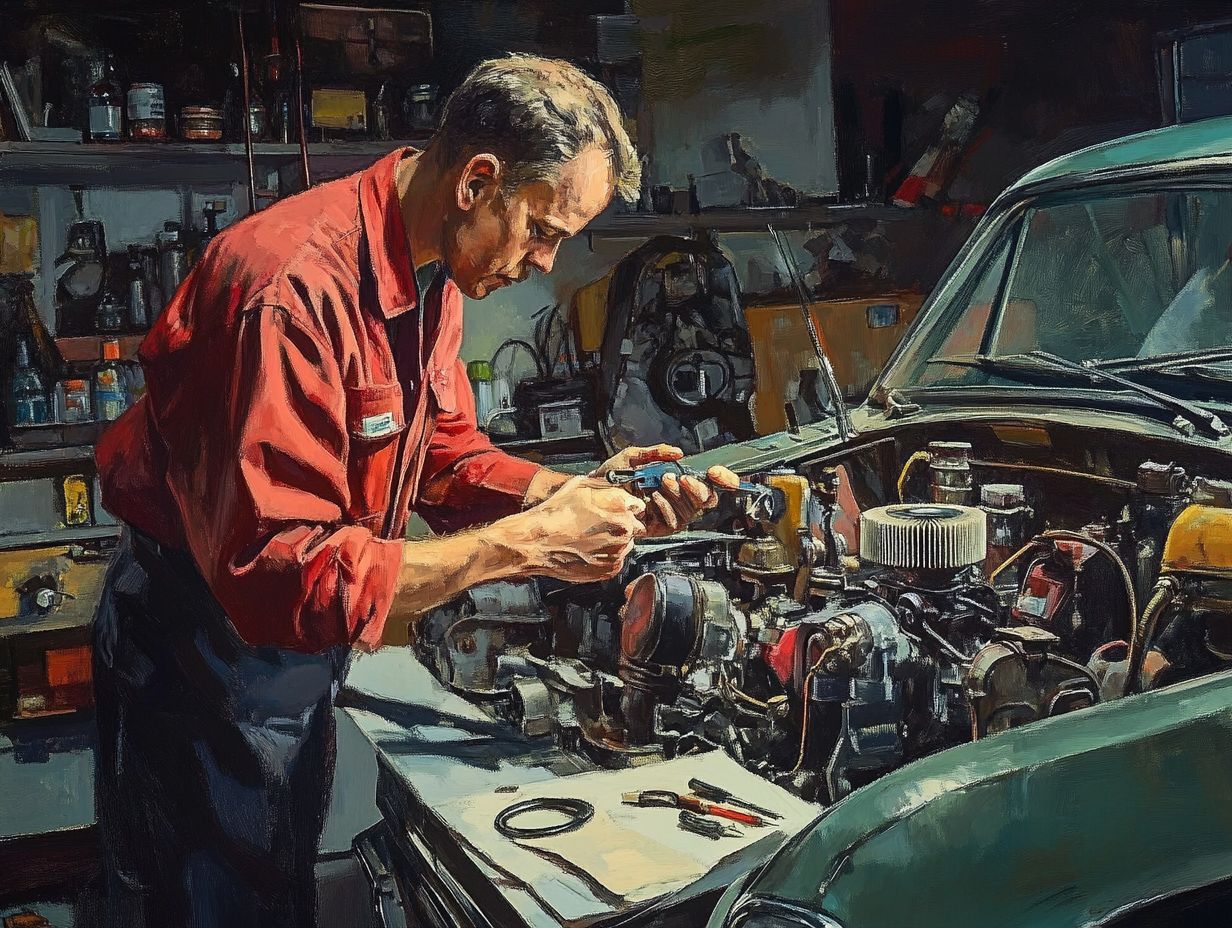
Maintaining properly inflated tires directly influences how often you face common car repairs. It s essential for preserving the integrity of your suspension system and enhancing your vehicle s overall performance.
When your tires are either under-inflated or over-inflated, uneven weight distribution can compromise your vehicle’s stability. This leads to increased stress on suspension components, resulting in premature wear and more frequent repairs, which can quickly become an expensive affair.
To steer clear of these issues, make it a habit to check your tire pressure at least once a month and adjust as necessary for optimal performance. Paying attention to visible wear on your tires and ensuring proper alignment will further extend the lifespan of both your tires and suspension components.
In doing so, you’ll save money on costly repairs while enhancing your driving safety.
Why Is It Important to Replace Worn Out Windshield Wipers?
Replacing worn-out windshield wipers is essential for maintaining visibility in various driving conditions. Ineffective wipers can jeopardize your safety, leading to accidents caused by poor visibility.
Driving in heavy rain or snow demands effective wipers for safety. If your wipers aren t performing their best, this can severely limit your ability to see the road ahead.
Many drivers tend to overlook the importance of regularly replacing their wipers. It s advisable to do so every six to twelve months to ensure optimal performance.
Investing in high-quality wipers not only improves the clearing of rain and debris but also enhances your overall driving safety by reducing glare and streaking. Don t wait until the next storm hits replace your wipers now for safer driving!
How Can Changing Your Air Filter Improve Your Car’s Performance?
Changing your air filter can significantly elevate your car’s performance. It enhances fuel efficiency, ensures a clean air supply for the engine, and prolongs its overall health.
When you have a clean air filter, your engine can breathe freely, promoting better fuel burning and minimizing fuel waste during operation. This not only improves your gas mileage but also reduces emissions (pollutants released into the air), contributing to a more sustainable environment.
To know when it s time for a replacement, watch for signs like decreased acceleration, unusual engine noises, or even black smoke billowing from the exhaust. Ignoring the need for a new filter can place unnecessary strain on your engine and lead to costly repairs later on.
Regularly changing your air filter keeps your car running smoothly and saves you money!
What Are the Steps to Changing a Flat Tire?
Changing a flat tire is a straightforward process that gives you the power to handle emergencies effectively, ensuring you stay safe and mobile during emergencies.
By equipping yourself with the right tools and knowledge, you can confidently tackle tire emergencies. Begin by gathering all necessary tools, including a spare tire, a jack, and a lug wrench. Also, ensure that safety gear, such as reflective vests and hazard cones, is within easy reach.
Next, take the time to familiarize yourself with your vehicle’s specific procedures, as these can vary between makes and models. Additionally, understanding the most common vehicle repairs can be beneficial. Always work on a flat, stable surface and engage the parking brake to prevent any rolling.
Regularly practicing this process not only builds familiarity but can also significantly reduce panic during unexpected flat tire situations. Preparing today ensures a sense of peace of mind for tomorrow.
Frequently Asked Questions
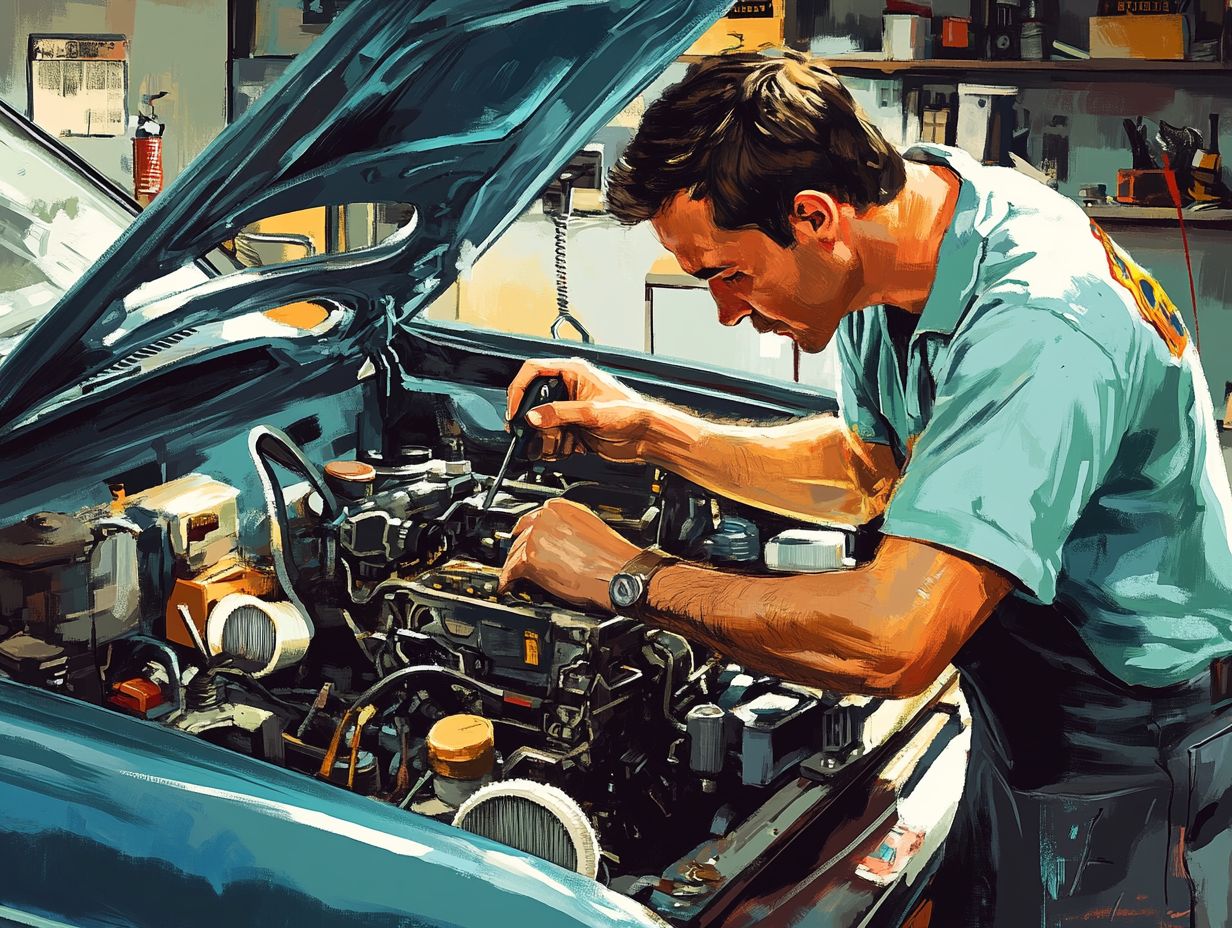
What are some tips for quick common car repairs?
1. Keep a well-stocked tool kit in your car. This should include basic tools like screwdrivers, pliers, a wrench, and a tire iron, along with knowledge of common repairs every new driver should know.
2. Always have spare fuses handy. Fuses often cause electrical issues in cars, and having spares can save you time and money.
3. Check your car’s fluids regularly. This includes oil, coolant, brake fluid, and windshield wiper fluid. Keeping these fluids at proper levels can prevent costly repairs down the line, and having the right tools is crucial. Consider reviewing the essential tools for common car repairs to ensure you’re prepared.
4. Learn how to change a flat tire. This basic skill can save you a lot of time and hassle if you find yourself with a flat tire on the road. For more information, check out this comprehensive guide on common car repairs.
5. Invest in a portable jump starter. This handy tool can save you from having to call for roadside assistance if your car battery dies.
What should I do if my car won’t start?
1. Check the battery connections. Ensure they are clean and tight. If they are loose, tighten them and try starting the car again.
2. If the battery connections are fine, try jump starting your car with another vehicle or a portable jump starter.
3. If jump starting doesn’t work, your battery may need to be replaced. Take your car to a mechanic to have it tested and replaced if necessary.
How can I fix a squeaky belt on my car?
1. Check the tension of the belt. If it’s too loose, it can cause squeaking. Use a tool to measure how tight the belt is.
2. If the tension is fine, the belt may need to be replaced. Look for signs of wear and tear or cracks on the belt.
3. If the belt needs replacing, also check the pulleys and other components that the belt runs on for any damage or wear.
What should I do if my car is overheating?
1. Pull over to a safe location and turn off the engine immediately. Let the car cool down your safety depends on it!
2. Check the radiator for any leaks or signs of damage. If you find any, you may need to have the radiator repaired or replaced.
3. If there are no visible issues with the radiator, check the coolant level and top it off if necessary. Also, check for any leaks in the hoses or connections.
4. If your car keeps overheating, don t wait! Get it towed to a mechanic for a thorough check!
What can I do to prevent my car from overheating?
1. Regularly check and maintain your car’s cooling system. This includes checking the coolant level, replacing the coolant every 2-3 years, and flushing the system every 5 years.
2. Park in the shade or use a reflective windshield cover to keep the temperature inside the car lower.
3. If you live in a warmer climate, consider using coolant with a higher boiling point to withstand high temperatures.
4. Check the condition of your radiator and have it cleaned or repaired if necessary.
5. If you notice your car’s temperature gauge rising, turn off the AC and turn on the heater to help dissipate heat from the engine.
Don’t hesitate to learn these quick fixes they can save you time and money on the road!

